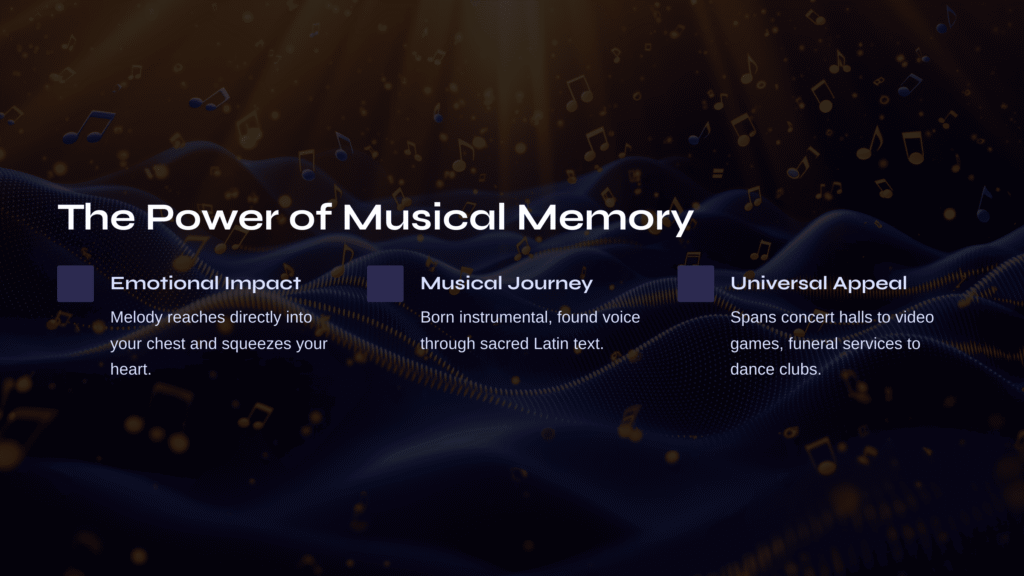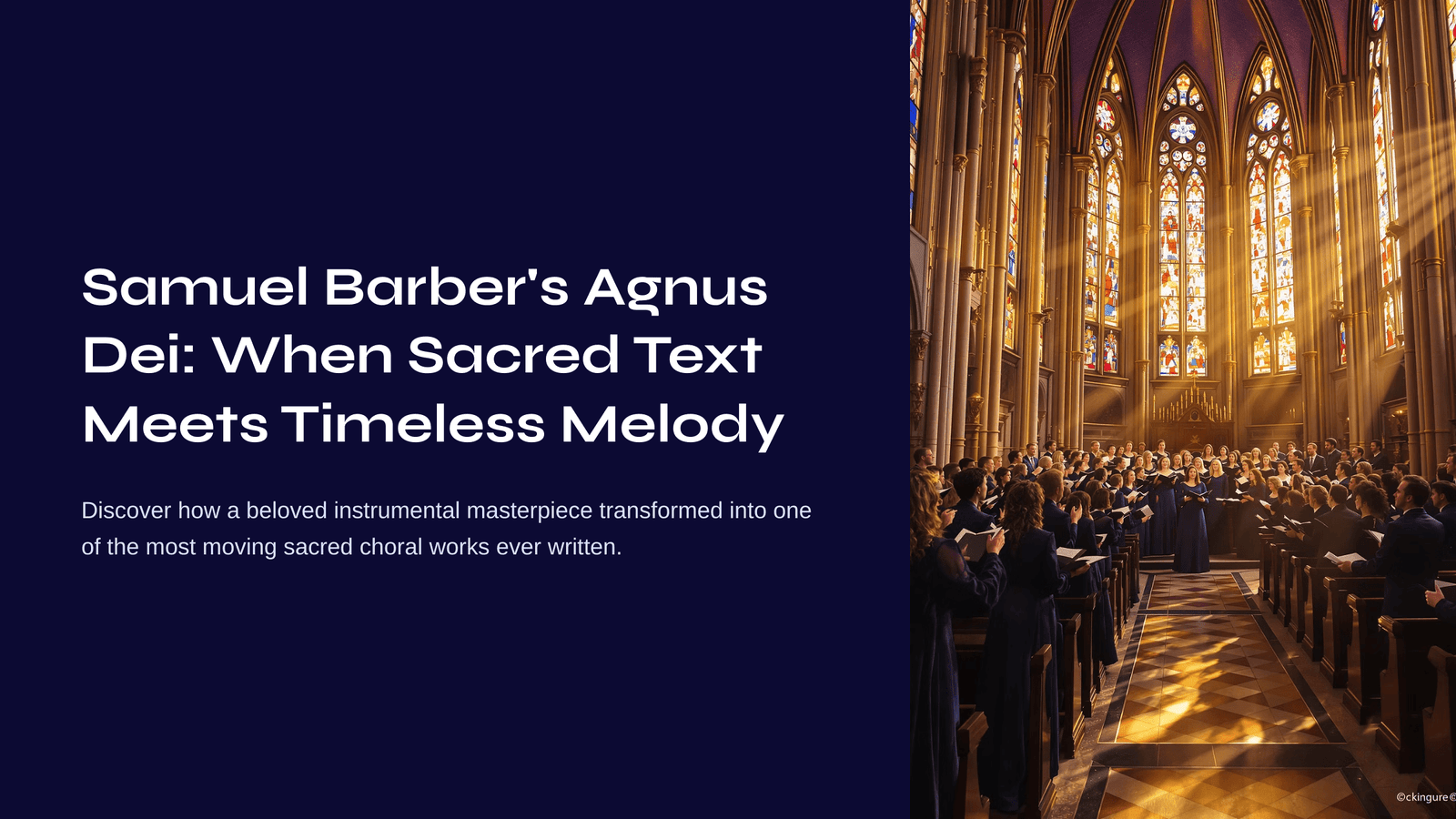Table of Contents

The Power of Musical Memory
There’s something magical about a melody that stays with you long after the last note fades. You know that feeling when a piece of music seems to reach directly into your chest and squeeze your heart? That’s exactly what happens when you encounter Samuel Barber’s Agnus Dei. It’s one of those rare compositions that doesn’t just play in the background of your life—it becomes part of your emotional landscape, a soundtrack to moments of reflection, loss, and hope.
What makes this piece even more fascinating is its incredible journey. Born as an instrumental work, it eventually found its voice through sacred Latin text, creating something entirely new yet timelessly familiar. It’s a story of musical evolution that spans decades and touches on everything from concert halls to video games, from funeral services to dance clubs.

From Quartet to Choir: A Composer’s Journey
Samuel Barber never intended to become famous for what would essentially be the same melody told in different ways. In 1936, the 26-year-old composer was spending a European summer with his companion Gian Carlo Menotti when he crafted what would become the second movement of his String Quartet No. 1, Op. 11. Barber was so pleased with this particular movement that he reportedly called it a “knockout.”
The original quartet movement was inspired by Virgil’s Georgics, those ancient Roman poems about rural life and the relationship between humans and nature. There’s something beautifully circular about this inspiration—from ancient poetry about the earth’s cycles to a musical meditation that would eventually carry sacred text about eternal themes.
Conductor Arturo Toscanini changed everything when he premiered the orchestral version with the NBC Symphony Orchestra in 1938. The piece, originally titled “Adagio for Strings,” became an instant sensation, broadcast live across America. But Barber wasn’t finished with this melody yet.
In 1967, thirty years after its creation, Barber made a remarkable decision. He took his beloved Adagio and gave it words—specifically, the Latin text of the Agnus Dei from the Catholic Mass. This wasn’t just an arrangement; it was a transformation. The composer had observed how audiences responded to his music, often associating it with mourning, passion, and spiritual longing. By adding the sacred text “Agnus Dei” (Lamb of God), he was acknowledging and embracing this spiritual dimension that listeners had already discovered.

A Musical Architecture of Prayer
When you listen to Barber’s Agnus Dei, you’re experiencing a masterclass in musical architecture. The piece unfolds over approximately eight minutes in B-flat minor, marked “molto adagio” and “molto espressivo”—very slowly and very expressively. But within this deliberate pace lies a world of subtle complexity.
The composition opens with the soprano voice alone, introducing the main melody with the words “Agnus Dei.” The melody itself is deceptively simple—long notes that flow in gentle waves, mostly moving step by step through the scale. But Barber sets the word “Agnus” to a beautiful melisma, where a single syllable spreads across multiple notes, creating an almost plaintive call.
Other voices enter a half-beat later, creating rich harmonies that support and comment on the soprano line. It’s like watching ripples spread across still water—each voice adds its own layer to the expanding circle of sound.
The middle section brings dramatic contrast. “Qui tollis peccata mundi” (who takes away the sins of the world) features descending melodic lines that seem to embody the weight of sin itself. When the music reaches “miserere nobis” (have mercy on us), there’s a profound sense of human vulnerability and pleading.
But it’s the final “dona nobis pacem” (grant us peace) that provides the piece’s emotional climax. All voices soar to extreme high notes in a fortissimo outcry that feels like the desperate prayer of humanity itself. Then comes silence—a long, pregnant pause that makes the soft return of “dona nobis pacem” in low voices feel like a whispered answer to prayer.

The Sacred Text That Transforms Everything
The Latin text that Barber chose carries centuries of meaning. “Agnus Dei, qui tollis peccata mundi, miserere nobis” appears twice, followed by “Agnus Dei, qui tollis peccata mundi, dona nobis pacem.” In English: “Lamb of God, who takes away the sins of the world, have mercy on us” (twice), then “Lamb of God, who takes away the sins of the world, grant us peace.”
This text has been part of the Catholic Mass since the 7th century, but its roots go even deeper into early Christian worship. The image of Christ as a sacrificial lamb connects to the most fundamental Christian beliefs about redemption and sacrifice. When Barber set these words to his already emotionally powerful melody, he created something that transcends religious boundaries—a universal prayer for mercy and peace.
What’s remarkable is how naturally the Latin text fits the existing melody. It’s as if the music was always waiting for these words. The long melismas on “Agnus” create space for contemplation, while the rising lines on “dona nobis pacem” transform what was once instrumental yearning into articulated hope.

My Personal Journey with This Music
I have to confess something: the first time I really heard this piece—I mean really listened to it—I was completely unprepared for the emotional impact. I was listening to a recording by The Sixteen under Harry Christophers when the final “dona nobis pacem” section began its climb toward that devastating climax. By the time all voices reached their peak and then fell into silence, I found myself holding my breath.
There’s something about the way Barber handles that climactic moment that feels both inevitable and surprising. You can sense the music building toward something, but when it arrives, the sheer intensity is almost overwhelming. It’s followed by that profound silence—not just an absence of sound, but a presence of quiet that seems to contain all the weight of what came before.
The return of “dona nobis pacem” in low voices after that silence feels like emerging from a storm into unexpected calm. It doesn’t provide easy comfort, but rather a kind of hard-won peace that acknowledges suffering while still believing in the possibility of redemption.

How to Truly Listen: A Guide to Deeper Appreciation
If you want to experience this piece fully, here’s what I recommend: Find a good recording (I particularly love the versions by The Sixteen or VOCES8), put on headphones, and give yourself permission to really listen. Don’t multitask. Don’t check your phone. Just listen.
Pay attention to how the voices enter—that staggered beginning creates an almost breathing quality, as if the music itself is taking its first careful breath. Notice how the melody passes between voice parts. The soprano introduces it, but listen for when it moves to the alto, then bass, then tenor. Each voice brings its own color to the same musical line.
Watch for the text painting—how the music illustrates the words. The descending lines on “peccata mundi” (sins of the world), the building intensity toward “dona nobis pacem” (grant us peace), the way certain words get extended treatment while others move more quickly. Barber wasn’t just setting text to music; he was creating a musical sermon.
Try listening with the score if you can read music, or even just the text translation if you can’t. Understanding what the choir is actually saying adds layers of meaning to the musical experience. But also try listening without thinking about the words at all—let the pure sound wash over you and see what emotions arise naturally.

Why This Music Endures
Samuel Barber’s Agnus Dei occupies a unique place in the choral repertoire because it successfully bridges multiple worlds. It’s classical music that speaks to popular audiences, sacred music that moves secular listeners, American composition rooted in European tradition, and 20th-century innovation that feels timeless.
The piece has found its way into contexts Barber probably never imagined. It’s been used in films, television shows, and even video games (most notably in the space strategy game Homeworld, where it provides a haunting accompaniment to cosmic destruction and hope). Electronic music producers have sampled and remixed it, introducing Barber’s melody to entirely new audiences through dance clubs and streaming platforms.
Yet it maintains its power in traditional settings too. Church choirs around the world perform it regularly, finding in its combination of musical sophistication and spiritual directness something that speaks to contemporary congregations. Professional choirs include it in their core repertoire because it challenges singers technically while offering profound artistic rewards.
The secret to its enduring appeal lies in Barber’s ability to create music that feels both personal and universal. The melody itself has an almost vocal quality—it seems to follow the natural rise and fall of human speech and breathing. When actual voices finally sing it, it feels like the music has found its true home.

A Legacy That Continues to Grow
Looking at Samuel Barber’s Agnus Dei today, what strikes me most is how it continues to find new life in unexpected places. During the pandemic, the Choir of the Earth project brought singers from around the world together virtually to perform this piece, creating a global community united by shared musical experience. Young choirs discover it and are amazed by its emotional power. Seasoned musicians return to it again and again, finding new details with each encounter.
This isn’t just a piece of music—it’s become a kind of musical touchstone for times when we need beauty, consolation, or hope. In a world that often feels chaotic and divided, Barber’s transformation of his instrumental masterpiece into a prayer for peace feels more relevant than ever.
The journey from string quartet to orchestral showpiece to sacred choral work reminds us that great music isn’t fixed in stone. It can evolve, adapt, and find new voices while retaining its essential truth. In giving his beloved melody these sacred words, Barber created something that speaks to our deepest human needs: the need for mercy, for peace, and for the kind of beauty that makes suffering bearable and hope possible.
When those final voices whisper “miserere nobis” and fade into silence, we’re left not with answers, but with something perhaps more valuable—the sense that our longing itself is sacred, and that in sharing our prayers through music, we create the very peace we seek.

If You Loved This, Listen to This Next
If you were moved by the profound spiritual beauty and intimate vocal expression of Barber’s Agnus Dei, you’ll find yourself equally captivated by Rheinberger’s Abendlied Op. 69 No. 3 – where similar contemplative qualities and masterful choral writing create an evening prayer that transforms simple devotion into transcendent musical poetry. Both works demonstrate how sacred text, when paired with genuinely inspired melody, can create moments of pure spiritual communion that speak to believers and music lovers alike.



